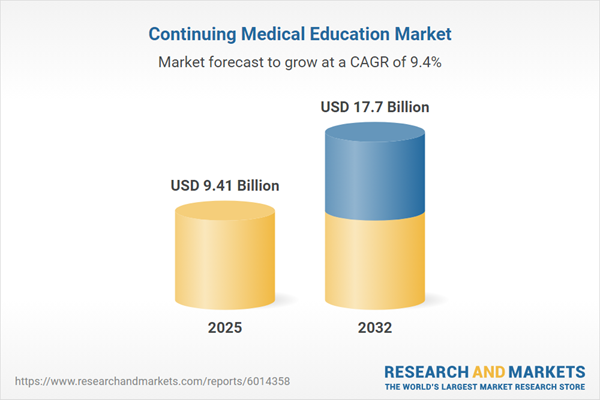Speak directly to the analyst to clarify any post sales queries you may have.
The continuing medical education market is evolving rapidly as healthcare organizations prioritize advanced learning models, data-driven approaches, and regional adaptation to maintain clinical and regulatory standards.
Market Snapshot: Continuing Medical Education Market Growth and Outlook
The continuing medical education market grew from USD 8.63 billion in 2024 to USD 9.41 billion in 2025. It is expected to advance at a CAGR of 9.39%, reaching USD 17.70 billion by 2032. Sustained momentum is driven by the increasing need for adaptable education platforms, policy alignment, and technology adoption, which enable clinicians and providers to meet evolving standards. Expansion reflects a move toward immersive digital experiences and strategic partnerships spanning global regions and specialties.
Scope & Segmentation
This report delivers an in-depth analysis and revenue forecasts across a comprehensive range of market segments, providing actionable insights for senior decision-makers.
- Delivery Mode: Includes in-person solutions such as conferences, seminars, symposia, and workshops, as well as online and remote formats including e-learning courses, virtual simulations, and webinars.
- Specialty: Covers core therapeutic areas such as cardiology, emergency medicine, family medicine, internal medicine, neurology, obstetrics and gynecology, oncology, pediatrics, psychiatry, and surgery.
- Provider: Examines offerings by academic institutions (medical schools, universities), commercial organizations (medical device and pharmaceutical companies), government agencies (health departments, regulatory bodies), and professional societies and associations (medical associations, specialty societies).
- Target Audience: Assesses needs and participation trends among dentists, nurses, and physicians.
- Region: Analyses developments across the Americas (United States, Canada, Mexico, Brazil, Argentina, Chile, Colombia, Peru), Europe, the Middle East, and Africa (United Kingdom, Germany, France, Russia, Italy, Spain, Netherlands, Sweden, Poland, Switzerland, United Arab Emirates, Saudi Arabia, Qatar, Turkey, Israel, South Africa, Nigeria, Egypt, Kenya), and Asia-Pacific (China, India, Japan, Australia, South Korea, Indonesia, Thailand, Malaysia, Singapore, Taiwan).
- Leading Companies Assessed: Includes 3M Company, Abbott Laboratories, B. Braun SE, Baxter International Inc., BD (Becton, Dickinson and Company), Boston Scientific Corporation, Cardinal Health, DJO Global, GE Healthcare, Johnson & Johnson, Koninklijke Philips N.V., McKesson Medical-Surgical, Med Learning Group, Medtronic, Oracle, Pfizer, Siemens Medical Solutions USA, Stryker, Veradigm, WebMD, Zimmer Biomet.
Key Takeaways for Senior Decision-Makers
- Digital transformation is central, with immersive simulations and e-learning courses reshaping delivery and access across medical specialties.
- Regional market dynamics reflect disparities in infrastructure, regulation, and technology adoption, requiring tailored approaches for local engagement and compliance.
- Collaboration between academic, commercial, and governmental stakeholders supports innovative program development and expands reach to underserved audiences.
- A focus on outcomes-based education, utilizing data analytics to refine content and validate clinical impact, is growing as a differentiator among providers.
- Segment-specific strategies, enabling flexible participation via both in-person and digital formats, help address learning preferences among physicians, nurses, and dentists.
- The vendor landscape features leaders advancing experiential modalities, analytics platforms, and ecosystem partnerships to enhance educational efficacy and operational agility.
Tariff Impact: Navigating Regulatory and Economic Change
Upcoming United States tariff adjustments in 2025 are set to affect supply chains for printed materials, simulation equipment, and audiovisual technologies. Organizations are adapting procurement and sourcing strategies, considering domestic production or digital offerings to mitigate cost volatility. Proactive modeling of tariff effects supports pricing strategies and margin preservation across multi-year planning cycles. Digital course providers, less exposed to physical supply disruption, must remain attentive to potential fee increases on internationally sourced software tools.
Methodology & Data Sources
This report synthesizes secondary research from regulatory and academic publications with primary data from executive interviews and learning platform analytics. Mixed-method analysis ensures validated findings, while expert review panels contribute practical relevance and accuracy.
Why This Report Matters
- Enables decision-makers to identify growth opportunities and anticipate market shifts with strategic confidence.
- Delivers clarity on evolving educational models, regulatory changes, and the interplay between technology and learning outcomes.
- Equips organizations to inform investment, partnership, and content development strategies based on granular, actionable insights.
Conclusion
The continuing medical education market is moving toward more flexible, data-validated, and collaborative models. Organizations that leverage technology, respond to regional demands, and pursue evidence-based program design will support improved clinical competency and sustainable growth.
Additional Product Information:
- Purchase of this report includes 1 year online access with quarterly updates.
- This report can be updated on request. Please contact our Customer Experience team using the Ask a Question widget on our website.
Table of Contents
3. Executive Summary
4. Market Overview
7. Cumulative Impact of Artificial Intelligence 2025
Companies Mentioned
The companies profiled in this Continuing Medical Education market report include:- 3M Company
- Abbott Laboratories
- B. Braun SE
- Baxter International Inc.
- BD (Becton, Dickinson and Company)
- Boston Scientific Corporation
- Cardinal Health, Inc.
- DJO Global, Inc.
- GE Healthcare
- Johnson & Johnson
- Koninklijke Philips N.V.
- McKesson Medical-Surgical Inc.
- Med Learning Group, LLC
- Medtronic PLC
- Oracle Corporation
- Pfizer Inc.
- Siemens Medical Solutions USA, Inc.
- Stryker Corporation
- Veradigm LLC
- WebMD LLC
- Zimmer Biomet Holdings, Inc.
Table Information
| Report Attribute | Details |
|---|---|
| No. of Pages | 190 |
| Published | November 2025 |
| Forecast Period | 2025 - 2032 |
| Estimated Market Value ( USD | $ 9.41 Billion |
| Forecasted Market Value ( USD | $ 17.7 Billion |
| Compound Annual Growth Rate | 9.3% |
| Regions Covered | Global |
| No. of Companies Mentioned | 22 |









